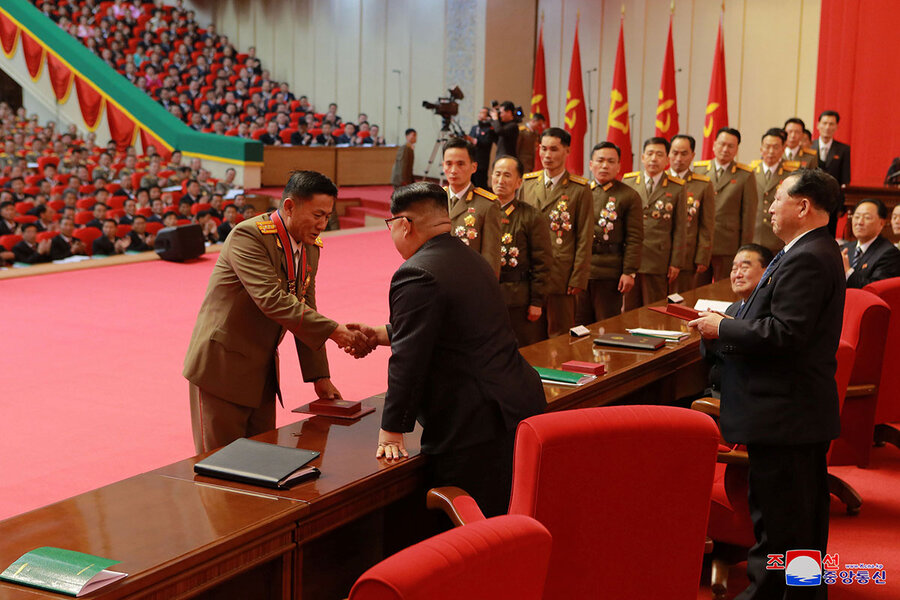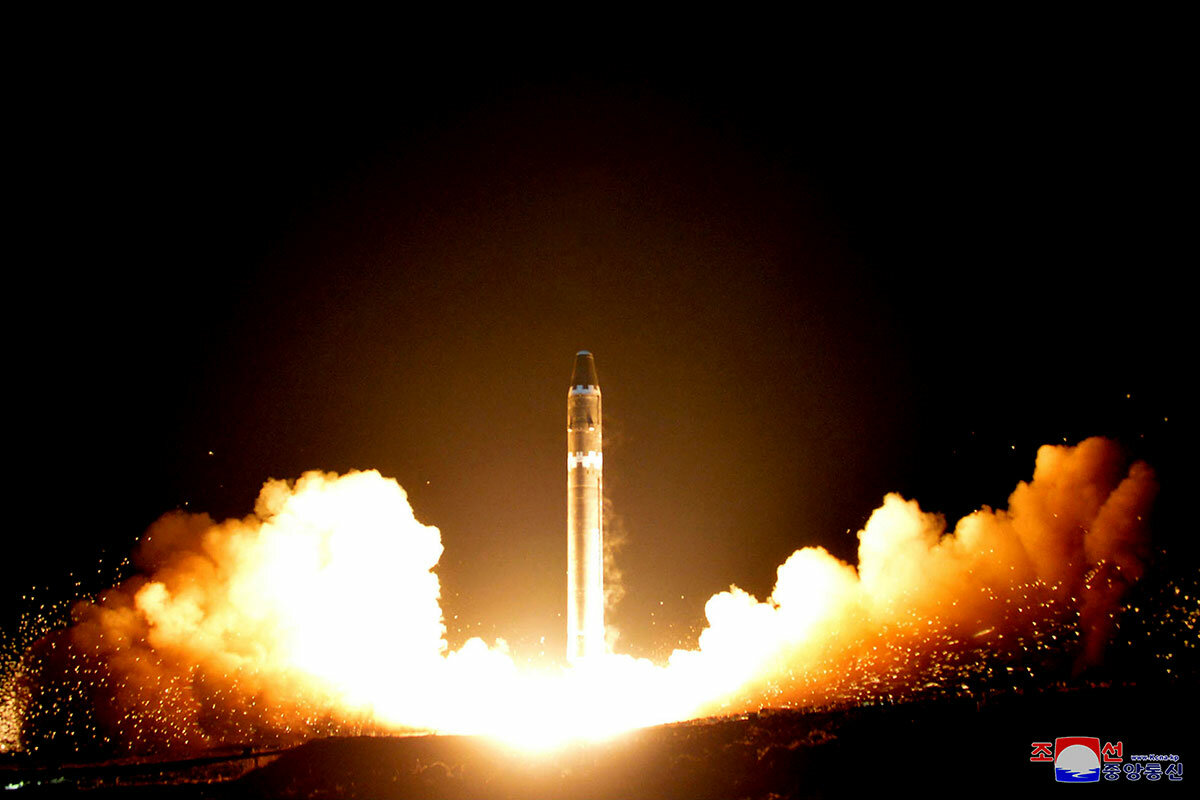With submarine program, N. Korea signals surge toward full nuclear deterrence
Loading...
This year North Korea says it has tested its first hydrogen bomb and an intercontinental ballistic missile with the range to reach the entire continental United States. What’s next for Pyongyang’s nuclear program? Perhaps construction of its first operational ballistic missile submarine.
Movement of parts and equipment at a key North Korean shipyard indicate workers are assembling a new missile sub on an “accelerated schedule,” according to 38 North, an analysis site run by the US-Korea Institute of Johns Hopkins School of Advanced International Studies. Clues revealed by surveillance photos include large hull sections near construction halls and a test stand likely used for missile-ejection tests.
Even if it becomes successfully armed with nuclear weapons, one missile sub by itself might not be worrisome, from the US point of view. It would add a complication for defense planning more than an entirely new strategic threat. The sub itself almost certainly will be too noisy to get from the Korean coastline undetected.
It’s the direction of the sub program, and what it represents, that’s perhaps the problem. The diversity of North Korea’s nuclear-capable weapons is expanding at a rate that’s surprised US experts. Pyongyang may be moving quickly toward full-spectrum nuclear deterrence, a multi-prong plan intended to protect the existing regime against conventional as well as nuclear attack.
It’s part of a doctrine called “asymmetric escalation,” says one expert, who judges that North Korea has already constructed a strategic force capable of plausibly carrying it out.
“I think we have to assume from a policy perspective that they plausibly do – certainly enough that I wouldn’t risk New York or DC to find out,” says Vipin Narang, a proliferation expert and associate professor of political science at the Massachusetts Institute of Technology, in an email response to a reporter’s inquiry.
A pivotal year
Yes, doubts remain about how big the gaps are in the regime's present capabilities, such as whether its warheads can withstand the forces of reentering Earth’s atmosphere in a long-range attack. But 2017 was the year North Korea’s nuclear capabilities emerged as a real strategic problem for the United States and its allies.
Before January it seemed more a notional or emerging program. Missile tests sometimes went awry, perhaps due to secret US cyber-interference with North Korean systems. North Korean nuclear tests were scary, but in the scale of things atomic, relatively small.
That changed on Sept. 3, when Pyongyang tested a nuclear device whose estimated yield was at least 140 kilotons. Previous North Korean tests had not surpassed about 20 kilotons. Many US experts believe an explosion that size shows North Korea has indeed acquired the expertise to build a true hydrogen bomb.
Then on Nov. 28, North Korea test launched a big new missile, the Hwasong-15. Launched relatively vertically, this ICBM went about 600 miles high. If fired on a lower trajectory, its range would be about 8,100 miles, according to US calculations. That means it could reach the big cities of the continental US, including those on the East Coast.
Overall North Korea had about 20 test ballistic-missile launches in 2017, a tick fewer than the 24 of 2016. The impressive – or concerning – aspect of this program was that it demonstrated a number of new short- and medium-range missile types, alongside the long-range Hwasong-15. Pyongyang appears to be moving up a step on the ladder of technology, away from missiles based on old Soviet-era Scud technology to more advanced and reliable designs.
New shipyard activity
Enter the submarine-launched ballistic missile, or SLBM. North Korea already has an experimental Sinpo-class diesel electric sub that “may” be able to launch ballistic missiles, according to a Congressional Research Service report on North Korea’s nuclear capabilities. CRS says this sub might have been used in testing of a nascent North Korean SLBM, a two-stage, solid-fuel rocket dubbed the KN-11.
Now North Korean engineers are apparently working on a more operational version of this system. In late November 38 North reported that commercial satellite imagery had revealed new activity at the Sinpo South Shipyard, which specializes in submarine construction. Gantry cranes and towers had begun moving around. Photos showed several apparent sub pressure hull sections of about 7 meters in diameter lying on a ramp near an assembly building. A service tower in place suggested imminent missile-ejection tests.
In 2018 we’re likely to see North Korean tests related to SLBM development, says Melissa Hanham, a senior research associate in the East Asia Nonproliferation Program at the Middlebury Institute of International Studies at Monterey.
Missile engine tests done horizontally with solid fuel leave a characteristic burn mark, says Ms. Hanham. Ejection tests at Sinpo involve pitching the missiles into piles of soft dirt, also leaving characteristic and detectable impressions.
North Korea is also putting into service a second submersible ballistic-missile test stand barge at another shipyard, Hanham notes.
Why push forward to perfect SLBMs? Prestige might be one answer. But sub-launched missiles would also give North Korea more options. In a confrontation they would be one more thing for South Korea, Japan, and the US to track, though it is likely the sub would not travel too far from the Korean coastline.
However, it might be dangerous if at some point a North Korean ballistic missile sub could slip away and get behind the THAAD anti-missile systems of South Korea and Japan. THAAD radar has only a 120-degree field of view and thus theoretically an ocean-going submarine could hit them from behind.
They are also a means for North Korea to improve its solid fuel technology. North Korea has already developed a land-based version of the solid-fuel KN-11, mounted on caterpillar tracks like a tank. Solid-fuel rockets don’t require a lengthy fueling cycle prior to launch. They don’t need as many support vehicles. That makes them much harder to find and if necessary attack prior to launching.
“That’s the more worrisome thing,” says Hanham.
A two-pronged deterrence strategy
What this illustrates is that North Korea is not just developing individual nuclear weapons to wave at the US, as if fear alone is their goal. They’re developing a nuclear arsenal intended to implement a strategy that could well seem rational to North Korea’s leader Kim Jong-un.
The basis is this: North Korea’s nukes are intended to preserve the country’s current regime. That means they are meant to deter both a conventional invasion and any strategic nuclear exchange.
The basic idea is to use one set of nuclear weapons to prevent conventional war, while reserving longer-range and more powerful weapons to hold off nuclear annihilation by US forces, according to Dr. Narang of MIT. This is a doctrine of “asymmetric escalation,” adopted by countries with relatively weak conventional forces facing stronger foes.
With its short- and medium-range missile tests, North Korea has shown it has the capability to hit US military bases in South Korea, Japan, and Guam. In the event of an invasion of North Korean territory by these allies, Pyongyang might launch nuclear weapons at the US installations in the region to try and get that invasion to stop.
The Pyongyang leadership would then count on Washington fearing its long-range ICBMs and H-bomb enough to refrain from launching nuclear weapons in response to the regional attacks. The war might grind to a halt with the territorial status quo intact.
“And with [North Korea’s] ICBM and purported thermonuclear weapons test, I think we have to assume that they can deter American nuclear retaliation after that first use by plausibly holding major American cities at risk now,” emails Narang.
Of course, the human cost of any such conflict would be immense. US military bases in East Asia are located in populated areas; hundreds of thousands of civilians would likely be killed if North Korea launched nukes. But North Korea would count on Washington deciding in the end that it would not risk the destruction of a US city to launch nuclear retaliation.
We don’t know if this how the North Korean regime really thinks about nuclear strategy. But we do know that in its rhetoric, at least, North Korea has reached a turning point in how it refers to its own position.
On Dec. 22 North Korean state media said that Kim Jong Un in a speech to party leaders had declared his nation a nuclear power.
“Nobody can deny the entity of [North Korea] which rapidly emerged as a strategic state capable of posing a substantial nuclear threat to the US,” Kim said, according to the Korean Central News Agency.







